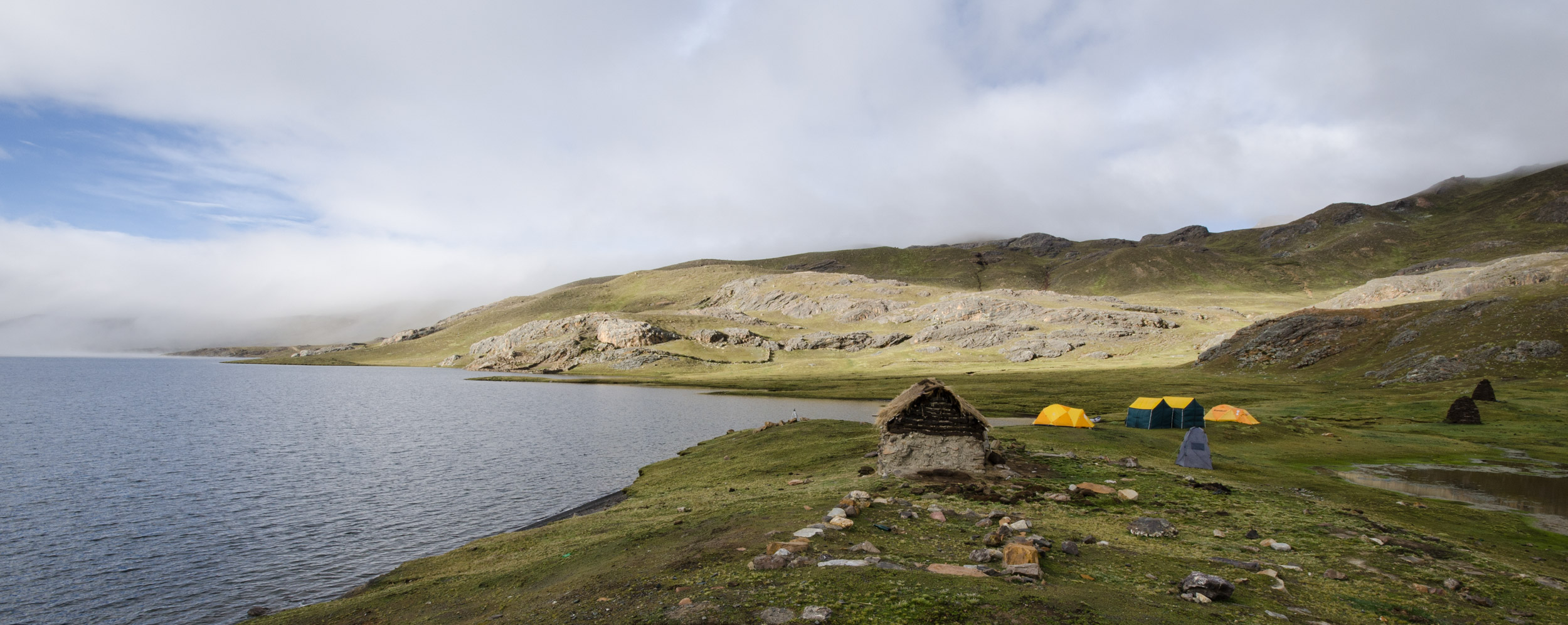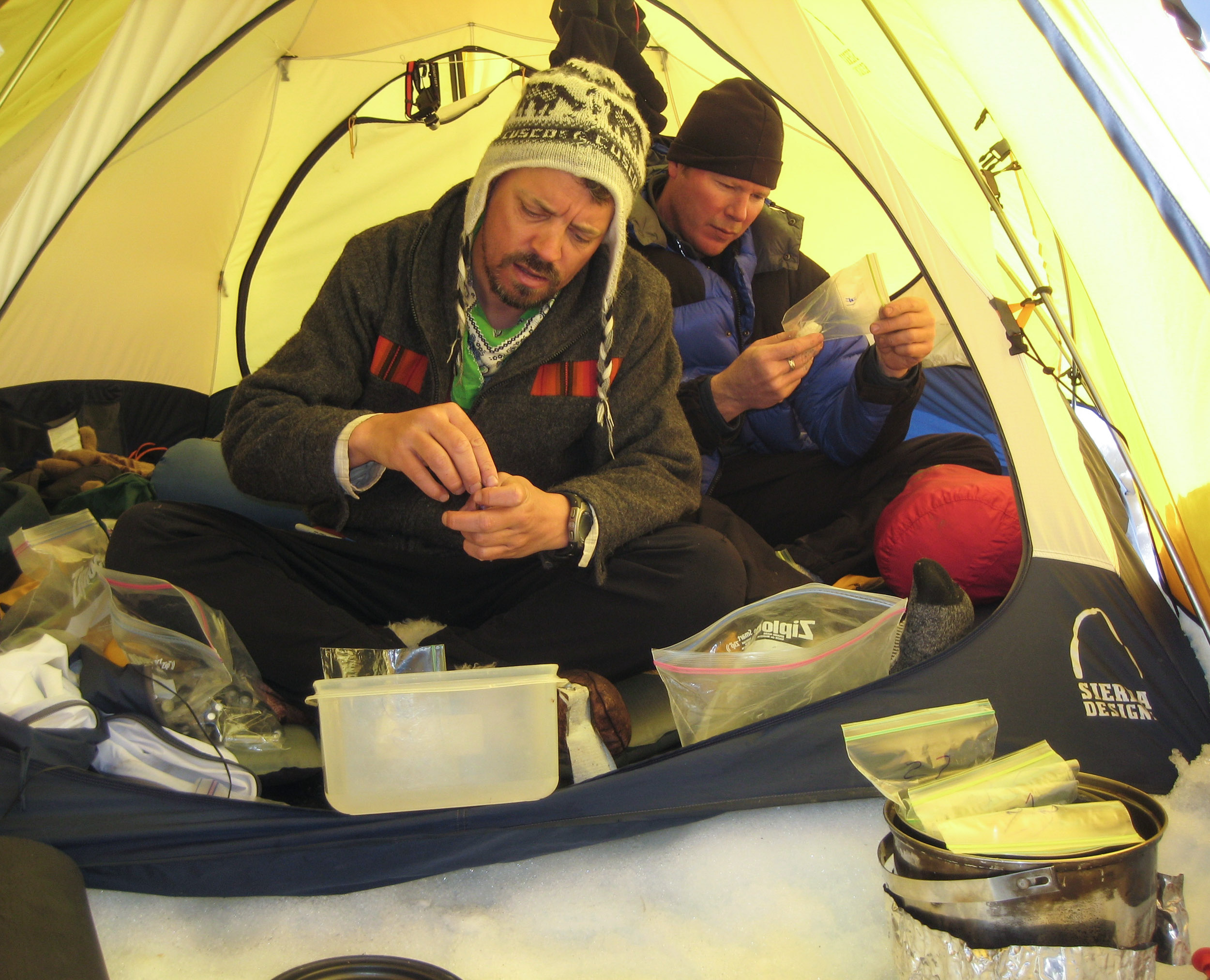Initiated in 1997 for Anton Seimon’s doctoral dissertation study at the University of Colorado-Boulder, this field research initiative in the Cordilleras Vilcanota and Carabaya in southern Peru has greatly expanded in scale and scope, and has over the years incorporated a multinational group of scientists. Funding support to cover or offset costs for many of these excursions has been obtained by grants from a variety of sources. These include NASA’s Earth System’s Science division, the Beverly Sears small grants program at the University of Colorado, the National Geographic Society, the National Science Foundation, CIRES at the University of Colorado, The Earth Institute at Columbia University, the Columbia Lamont-Doherty Climate Center, the ALARM consortium of the European Union, and private foundations and donors. Research foci have included regional climatology and climate history from ice core analysis; tropical deglaciation; climate change impacts on alpine ecological systems and highland human populations; surveys of avifauna, mammals and herps; emerging infectious disease of amphibians; soil microbial biology; environmental impacts of road building across ecological corridors; and social and environmental consequences of informal gold mining operations. These efforts have yielded the following scientific publications and media products.
Peer-reviewed Scientific Publications
Amphibians
Jenkins C.L. and P. Zahler: Using geographic information systems to identify hotspots of amphibian biodiversity in the Andes of southern Peru. Pp. 247-254. (2002) In: Proceedings of the Congress on Conservation of Biodiversity in the Andes and the Amazon Basin. (R.W. Bussman and S. Lange, eds.), INKA e.V. Munich, Germany.
Seimon A, Yager K, Seimon T.A., Schmidt S, Grau A, Beck S, García C, Tupayachi A, Sowell P, Touval J, and Halloy S. Changes in Biodiversity Patterns in the High Andes – Understanding the Consequences and Seeking Adaptation to Global Change. (2009) Mountain Forum Bulletin, Volume IX Issue 2, pp 25-27.
Seimon T.A. Global warming from a frog’s perspective: A call for immediate action. (2010) Acta zoológica lilloana 54 (1–2): 3–10.
Seimon T.A. Hoernig G., Sowell P., Halloy S., Seimon A. Identification of Chytridiomycosis in Telmatobius marmoratus at 4,450 m in the Cordillera Vilcanota of Southern Peru. (2005) In: E. O. Lavilla and I. De la Riva, (eds.), Studies on the Andean Frogs of the Genera Telmatobius and Batrachophrynus, 275-283. Asociación Herpetológica Española, Monografías de Herpetología, Valencia, Spain.
Seimon T.A., Seimon A. Halloy S., Musicante M. Herpetological monitoring on GLORIA summits. (2015) The GLORIA field manual – standard Multi-Summit approach, supplementary methods and extra approaches. 5th edition. GLORIA-Coordination, Austrian Academy of Sciences & University of Natural Resources and Life Sciences, Vienna. pp. 75-78.
Seimon T.A., Seimon A., Daszak P., Halloy S., Schloegel L. M., Aguilar C. A., Sowell P., Hyatt A., Konecky B., and Simmons J. Upward range extension of Andean anurans and chytridiomycosis to extreme elevations in response to tropical deglaciation. (2007) Global Change Biology, Vol.13: 288-299.
Seimon, T.A., Seimon A., Yager K.A., Reider K., Delgado A., Sowell P., Tupayachi A., Konecky B., McAloose D., Halloy S.R.P. Long-term monitoring of tropical alpine habitat change, Andean anurans, and chytrid fungus in the Cordillera Vilcanota, Peru: Results from a decade of study. (2017) Ecology and Evolution Feb 7;7(5):1527-1540. doi: 10.1002/ece3.2779. https://onlinelibrary.wiley.com/doi/abs/10.1002/ece3.2779
Von May R., Catenazzi A. A., Brown J.L., Carrillo J., Chávez G., Córdova J., Curo A., Delgado A., Enciso M.A., Gutiérrez R., Lehr E., Martínez J.L., Medina-Müller M., Miranda A., Neira D.R., Ochoa J.A., Quiroz A.J., Rodríguez D.A., Rodríguez L.O., Salas A.W., Seimon T.A. Seimon A., Siu-Ting K., Suárez J, Torres C., Twomey E. Current state of conservation knowledge on threatened amphibian species in Peru. (2008) Tropical Conservation Science, Vol. 1(4):376-396.
Climate Change
Barry, R.G., and A. Seimon: Climatic fluctuations in the mountains of the Americas and their significance. (2000) Ambio, 24, 364-370.
Halloy S, Yager K, García C, Beck S, Carilla J, Tupayachi A, Jácome J, Isela Meneses R, Farfán J, Seimon A, Seimon T, Rodriguez P, Cuello S, Grau A. South America: Climate monitoring and adaptation integrated across regions and disciplines. In Settele, J. (ed.), (2009) Atlas of Biodiversity Risks – from Europe to the globe, from stories to maps. Sofia & Moscow: Pensoft, Chapter 3, pages 86-91.
Halloy, S.R.P., A. Seimon, K. Yager and A. Tupayachi: Multi-dimensional (climatic, biodiversity, socioeconomic, and agricultural) context of changes in land use in the Vilcanota watershed, Peru. (2005) In Land Use Changes and Mountain Biodiversity. E.M. Spehn, M. Liberman and C. Körner (eds.), CRC Press, Boca Raton.
Halloy S.R.P., R. Ortega, K. Yager and A. Seimon. Traditional Andean cultivation systems and implications for sustainable land use. (2005) Acta Horticulturae, (ISHS) 670: 31-55
Seimon, A. Climatic variability and environmental response in an Andean alpine watershed, Cordillera Vilcanota, Peru. (2004) Doctoral dissertation, Department of Geography, University of Colorado at Boulder.
Seimon, A., Halloy, S.R.P., and T.A. Seimon: Recent observation of a proliferation of Ranunculus trichophyllus in high-altitude Lakes of the Mount Everest region: comment. (2007) Arctic, Antarctic and Alpine Research, 39(2), pp. 340–341.
Seimon, A.: Improving climatic signal representation in tropical ice cores: A case study from the Quelccaya Ice Cap, Peru. (2003) Geophysical Research Letters, 30, 1,772-1,776.
Seimon, A.: Peru’s Cordillera Carabaya: Dilemmas of Infrastructure and Energy Development in Remote Mountain Ranges. (2001) In Mountains of the World: Energy and Infrastructure. Mountain Agenda and the Swiss Agency for Development, Berne Switzerland.
Ecological Succession and Microbiology
Darcy, J.L. et al. 2016. Nutrient limitation of microbial phototrophs on a debris-covered glacier. Soil Biol. Biochemistry 95: 156-163.
Darcy, J.L., et al. 2011. Global distribution of Polaromonas phylotypes – evidence for a highly successful dispersal capacity. PLoS ONE 6: e23742.
Freeman, K.R., D. Karki, et al. 2009. Evidence that chytrids dominate fungal communities in high-elevation soils. Proceedings Natl. Acad. Sci. USA 106: 18315-18320. King, A.J. et al. 2010. Biogeography and habitat modelling of high-alpine bacteria. Nature Commun. 1:53 doi: 10.1038/ncomms1055.
Knelman J.E. et al. 2014. Nutrient addition dramatically accelerates microbial community succession. PLoS ONE 9: e102609.
Nemergut D.R. et al. 2016. Decreases in average bacterial community rRNA operon copy number during succession. ISME Journal 10: 1147-1156.
Nemergut, D.R. et al. 2005. Structure and function of alpine and arctic soil microbial communities. Res. Microbiology 156: 775-784.
Nemergut, D.R., S.P. Anderson, C.C. Cleveland, A.E. Miller, A. Seimon, S.K. Schmidt. 2007. Microbial community succession in unvegetated, recently-deglaciated soils. Microbial Ecol 53: 110-122.
Nemergut, D.R., T. Fukami et al. 2013. Patterns and processes of microbial community assembly. Microbiol. Molecular Biol. Rev. 77: 342-356.
Rhodes, M. et al. 2013. Structure and Function of Prokaryotic Communities in Soils of Cold Deserts. in E. Rosenberg, E. Delong et al. (eds.), The Prokaryotes, Springer-Verlag, Berlin.
Robeson, M.S. et al. 2011. Soil Rotifer communities are extremely diverse globally but spatially auto-correlated locally. Proceedings Natl. Acad. Sci. USA 108: 4406-4410.
Schmidt, S. K., Reed, S. C., Nemergut, D. R., Grandy, A. S., Cleveland, C. C., N.Weintraub, M., Hill, A., Costello, E. K., Meyer, A. F., Neff, J. C., and Martin, A. M. 2008. The earliest stages of ecosystem succession in high-elevation (5000 meters above sea level), recently deglaciated soils. Proceedings of the Royal Society B-Biological Sciences, 275: 2793-2802.
Schmidt, S.K., D. R. Nemergut, A. E. Miller, K.R. Freeman, A.J. King and A. Seimon. 2009. Microbial Activity and Diversity During Extreme Freeze-Thaw Cycles in Periglacial Soils, 5400 m Elevation, Cordillera Vilcanota, Peru. Extremophiles, 13: 807-816.
Schmidt, S. K., Sobieniak-Wiseman, L. C., Kageyama, S. A., Halloy, S. R. P., and Schadt, C. W. 2008. Mycorrhizal and Dark-Septate Fungi in Plant Roots above 4270 Meters Elevation in the Andes and Rocky Mountains. Arctic, Antarctic, and Alpine Research, 40: 576-583.
Schmidt, S.K. et al. 2016. Biogeochemical stoichiometry reveals P and N limitation across the post-glacial landscape of Denali National Park, Alaska. Ecosystems doi 10.1007/s10021-016-9992-z.
Schmidt, S.K., D. Karki et al. 2011b. Phylogeography of microbial phototrophs in the dry valleys of the high Himalayas and Antarctica. Proceedings Royal Society B. 278: 702-708.
Schmidt, S.K., D.R. Nemergut et al. 2008. The earliest stages of ecosystem succession in high-elevation (5000 m.a.s.l.), recently de-glaciated soils. Proceedings Royal Society B. 275: 2793-2802.
Schmidt, S.K., D.R. Nemergut et al. 2012. A simple method for determining limiting nutrients for photosynthetic crusts. Plant Ecology Diversity 5: 513-519.
Schmidt, S.K., D.R. Nemergut et al. 2014. Do bacterial and fungal communities assemble differently during primary succession? Molecular Ecology 23: 254-258.
Schmidt, S.K., D.R. Nemergut, S.C. Reed, A.J. King, P. Sowell. 2011a. Estimating phosphorus availability for microbial growth in an emerging landscape. Geoderma 163: 135-140.
Vimercati L. et al. 2016. Growth of a high-elevation Cryptococcus sp. during extreme freeze-thaw cycles. Extremophiles (doi 10.1007/s00792-016-0844-8).
Wildlife
Doyle, K.L., P. Zahler and C. Aucca Chutas. 2003. Biodiversity and the Case for Preservation of the Sibinacocha Watershed. Lyonia 4(1): 43-48.
Ferretti N., Cavallo P., Chaparro J.C., Ochoa J., Ríos-Tamayo D., Seimon T.A., West R. A. taxonomic revision of Hapalotremus Simon, 1903 (Araneae: Theraphosidae), with the description of seven new species and the highest altitude record for the family. Journal of Natural History. Vol 52, 29-30: 1927-1984. doi: 10.1080/00222933.2018.1506521. https://www.tandfonline.com/doi/abs/10.1080/00222933.2018.1506521


